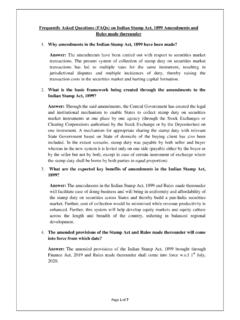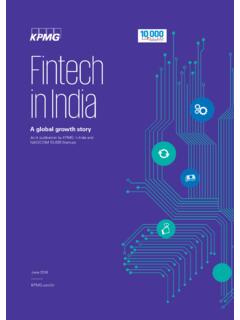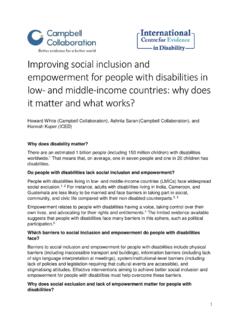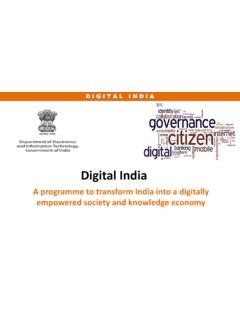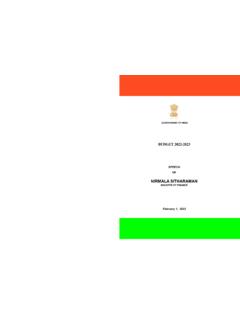Transcription of Fiscal Policy in India: Trends and Trajectory
1 0 Fiscal Policy in india : Trends and Trajectory Supriyo De* January, 2012 * Officer on Special Duty to the Chief Economic Adviser, Ministry of Finance, Government of india 1 Content Page No. Foreword 2 Disclaimer and acknowledgements 3 Abstract 3 Introduction 4 Basic concepts 5 india s Fiscal Policy architecture 6 Evolution of Indian Fiscal Policy till 1991 8 Liberalization, growth, inclusion and Fiscal consolidation (1991-2008) 14 Crisis and return to Fiscal consolidation: The maturing of Indian Fiscal Policy ? 20 Conclusion 25 References 26 2 Foreword In the rush to produce urgent Policy documents and briefing notes that any government has to do, it is easy to let matters that may not be quite as urgent to go unattended.
2 However, the not-so-urgent often includes matters of great importance for the long-run well-being of the nation and its citizenry. Research papers on topics of strategic economic Policy fall in this category. The Economic Division in the Department of Economic Affairs, Ministry of Finance, has initiated this Working Paper series to make available to the Indian policymaker, as well as the academic and research community interested in the Indian economy, papers that are based on research done in the Ministry of Finance and address matters that may or may not be of immediate concern but address topics of importance for india s sustained and inclusive development.
3 It is hoped that this series will serve as a forum that gives shape to new ideas and provides space to discuss, debate and disseminate them. Kaushik Basu January 18, 2011 Chief Economic Adviser 3 Disclaimer and Acknowledgements The author would like to express his gratitude to the Australia india Institute, University of Melbourne for hosting him for the Emerging Leaders Fellowship Programme during which this paper was largely written. Special thanks are due to the Director of the Institute, Professor Amitabh Mattoo for encouraging this effort. The author wishes to thank Professor Kaushik Basu, Dipak Dasgupta, Professor Tsunao Okumura and Professor Etsuro Shioji for encouragement for participating in the Emerging Leaders Fellowship Programme of the Australia india Institute.
4 Furthermore, the author thanks Professor Kaushik Basu for his invaluable suggestions and comments. Thanks are also due to Monica Sengupta De, without whose help and support, this endeavour would have been impossible. The views expressed in this essay are purely personal and do not necessarily express the views of the institutions the author is associated with. This is a technical, academic and research output. Abstract This essay examines the Trajectory of india s Fiscal Policy with a focus on historical Trends , Fiscal discipline frameworks, Fiscal responses to the global financial crisis and subsequent return to a Fiscal consolidation path.
5 The initial years of india s planned development strategy were characterised by a conservative Fiscal Policy whereby deficits were kept under control. The tax system was geared to transfer resources from the private sector to fund the large public sector driven industrialization process and also cover social welfare schemes. However, growth was anaemic and the system was prone to inefficiencies. In the 1980s some attempts were made to reform particular sectors. But the public debt increased, as did the Fiscal deficit. india s balance of payments crisis of 1991 led to economic liberalisation. The reform of the tax system commenced.
6 The Fiscal deficit was brought under control. When the deficit and debt situation again threatened to go out of control in the early 2000s, Fiscal discipline legalisations were instituted. The deficit was brought under control and by 2007-08 a benign macro- Fiscal situation with high growth and moderate inflation prevailed. During the global financial crisis Fiscal Policy responded with counter-cyclical measures including tax cuts and increases in expenditures. The post-crisis recovery of the Indian economy is witnessing a correction of the Fiscal Policy path towards a regime of prudence.
7 In the future, the focus would probably be on bringing in new tax reforms and better targeting of social expenditures. 4 Introduction Fiscal Policy deals with the taxation and expenditure decisions of the government. Monetary Policy , deals with the supply of money in the economy and the rate of interest. These are the main Policy approaches used by economic managers to steer the broad aspects of the economy. In most modern economies, the government deals with Fiscal Policy while the central bank is responsible for monetary Policy . Fiscal Policy is composed of several parts. These include, tax Policy , expenditure Policy , investment or disinvestment strategies and debt or surplus management.
8 Fiscal Policy is an important constituent of the overall economic framework of a country and is therefore intimately linked with its general economic Policy strategy. Fiscal Policy also feeds into economic Trends and influences monetary Policy . When the government receives more than it spends, it has a surplus. If the government spends more than it receives it runs a deficit. To meet the additional expenditures, it needs to borrow from domestic or foreign sources, draw upon its foreign exchange reserves or print an equivalent amount of This tends to influence other economic variables. On a broad generalisation, excessive printing of money leads to inflation.
9 If the government borrows too much from abroad it leads to a debt crisis. If it draws down on its foreign exchange reserves, a balance of payments crisis may arise. Excessive domestic borrowing by the government may lead to higher real interest rates and the domestic private sector being unable to access funds resulting in the crowding out of private investment. Sometimes a combination of these can occur. In any case, the impact of a large deficit on long run growth and economic well-being is negative. Therefore, there is broad agreement that it is not prudent for a government to run an unduly large deficit.
10 However, in case of developing countries, where the need for infrastructure and social investments may be substantial, it sometimes argued that running surpluses at the cost of long-term growth might also not be wise (Fischer and Easterly, 1990). The challenge then for most developing country governments is to meet infrastructure and social needs while managing the government s finances in a way that the deficit or the accumulating debt burden is not too great. This essay examines the Trajectory of india s Fiscal Policy with particular focus on historical Trends , the development of Fiscal discipline frameworks, the recent experience of Fiscal response to the global financial crisis and subsequent return to a Fiscal consolidation path.

